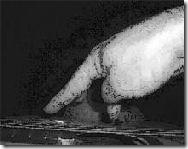Harmonics is a term used to describe a phenomenon whereby a pitch is created by plucking a string while lightly holding a finger against that string so that it doesn't touch the fretboard. The resulting note (or notes) will be a different pitch than would otherwise be produced—in the case of twelfth fret harmonics (a natural harmonic) the pitch produced will be one octave higher than the open string—by the unaltered string.
The term comes from the theoretical realm of acoustical science. The harmonic series is a mathematical definition used to explain the generation of frequencies from a root pitch. The harmonic series is important in musical applications because most instruments (including guitar) produce sounds that contain harmonic frequencies. The natural frequencies of the string form a harmonic series.
Consider the harmonic series in terms of musical intervals. The first harmonic is the fundamental. The second harmonic is an octave above. The third harmonic is an octave and a fifth above the fundamental. The fourth harmonic is two octaves above the fundamental. The fifth harmonic is another major third higher, the sixth is another minor third higher, etc.
Guitar 'harmonics' are created when you lightly touch the string with your finger at specific positions and then pluck the string. This causes both sections of the string, to the right and left of the spot you're touching, to vibrate simultaneously, giving a bell like quality to the note. It works only if the finger is removed quickly as you pluck. What is being accomplished is that the fundamental is being subtracted from the note and only the harmonics remain to be heard.
Natural harmonics are the easiest to produce. A good place to begin is the 12th fret of the first string. With your fretting hand, lightly touch the finger against the string directly above the 12th fret. Do not hold it down, just touch it. Then pluck it. Release the string with your fretting hand. If done correctly, the result should he a high-pitched, ringing E, the same note as normal fretting will produce. There are three points that are easiest to produce natural harmonics along the string: the fifth, seventh and twelfth frets—all directly above the fret-wire, not the wood between the wire. At these points, the string is divided exactly into fourths, thirds and halves respectively. At the 12th fret, they are the same note, at the 7th fret, the harmonic is one octave higher than the fretted note, the 5th fret, the harmonic is the 'fifth' of the fretted note, but 2 octaves higher. In other words, on the E string, the fretted note at the 5th fret is an A note, but the harmonic played at the 5th fret is an E note two octaves The purity of sound comes from these perfect fractions of string ringing together. If you try it anywhere else on the
string, you hear a very slight harmonic or nothing at all useful! Execute this technique at the 7th, 5th, and 4th frets, as in the list of natural harmonics: each will produce even higher sounds, much higher than can be produced on the guitar without using harmonics.
Artificial harmonics are those created on a string that is fretted by the right hand. The left hand must do the light touch while plucking it at the same time twelve frets away from the fretting hand. Fret the note normally, and place the picking hand index finger on a natural harmonic relative to the fretted note (just as in tapped harmonics). Pluck the string with another finger and release the index finger, just as if producing a natural harmonic. See the two accompanying photographs. The note being played is the octave harmonic one octave above the fretted ‘a' on the fifth fret of the first string.
Photo to left: PREPARATION.
Photo to right: RELEASE.
In the following piece, the 'B' section of the melody (sort of a recap of the last phrase of section 'A') is played using the artificial harmonic as described in the above paragraph. What makes this interesting and a moderate challenge is that the thumb and first finger must execute the harmonic while keeping the bass line and chordal accompaniment flowing. Feels impossible to the student on the first read-through. It isn't, and the result is a beautiufl, haunting little melody.













No comments:
Post a Comment